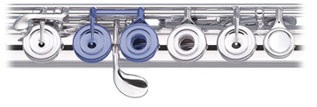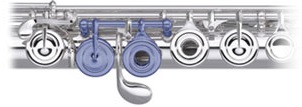Contents:
The Flute Family
Piccolo: Sounding one octave higher than the concert flute, the piccolo is used in solo, chamber, and ensemble performances. It is made of wood, metal, or composite materials.
Concert flute: The most familiar member of the flute family, this instrument is the traditional choice for band, orchestra, and solo playing. Often referred to simply as “flute,” it is pitched in C and most often made of metal.
Alto Flute: Larger than a concert flute, the alto flute is pitched in G and produces a lush, mysterious sound popular in chamber and orchestral music. Alto flutes are available with curved or straight headjoints depending on the player’s comfort and tonal preference.
Bass Flute: Commonly used in chamber music, the bass flute sounds one octave lower than the concert flute. It features a curved headjoint and larger tubing than the concert flute and requires tremendous embouchure flexibility.
Contrabass flute: The largest member of the flute family, the contrabass flute sounds two octaves below the concert flute. It requires a relaxed yet flexible embouchure and is used most frequently in flute choir or other chamber music settings. Because of its size, it must be played standing up.
Configuration Options
Inline G: The inline G places both the G and the A key on a single rod next to each other. Many flutists, especially those with longer fingers, prefer the hand position that the inline flute requires to play.

Offset G: A growing number of flutists prefer the comfort and hand position of the offset G key. Having a separate rod for the G means one less key on the A-Bb rod, and therefore easier maintenance.

Split E Mechanism: The split E divides the action of the upper and lower G keys, permitting the lower G to close when the third octave E natural is played. This mechanism ensures tonal stability of the high E, secure attacks, and smooth slurs between the third octave A and E.

High E Facilitator (G disk): An effective, economical alternative to the split E, this donut-shaped ring inserted into the lower G tone hole improves the response of the flute's high E without adversely affecting other notes. The high E facilitator can be added to any flute at any time and can also be removed later if desired.

C# Trill Key: This key allows many trills and tremolos to be played more easily, in addition to trilling from B or C to C#, making it a truly versatile addition. Many alternate fingerings are also available with this key option.

D# Roller: The D# roller helps to facilitate movement between the C# and D# keys of the footjoint, an often challenging area for even the most accomplished flutists.

C# roller: The C# roller provides additional ease of movement between the C# and D# keys.
Drawn tone holes: Drawn tone holes are seamlessly sculpted by drawing metal from the flute's body, giving a quick, flexible response and a rich, resonant timbre.
Soldered tone holes: Created by fusing separate rings to the flute’s tube, soldered tone holes yield slightly increased resistance. Because of the added weight, flutes with soldered tone holes are frequently characterized as dark or deep in timbre.
Engraving: Engraving may be added to certain flutes, enhancing the beauty of the instrument. A trained craftsperson etches intricate designs onto specific areas of the instrument, including the lip plate, keys, and crown to create a truly unique instrument.
Tubing & Metallurgy
Flutes are available in a variety of tubing thicknesses and metal compositions, each to suit the flutist’s individual needs. In general, adding more pure metal to an instrument, rather than plating, will enhance projection and overall resonance of the instrument.
Standard Wall: Flutes with standard tubing thickness produce rich, dark colors with very little resistance. They are free blowing and responsive.
Thin Wall: Commonly found in gold instruments, the thin wall tube offers flexibility free from the burden of weight. Thin wall flutes are characterized by their sweet, singing quality.
Medium Wall: Falling between the standard and heavy wall options, a medium wall offers the flexibility of standard tubing with slightly more resistance, producing a darker tone.
Heavy Wall: The most resistant tubing thickness, heavy wall flutes are prized for their lush sound and vast array of tonal possibilities. These flutes are physically much heavier than their standard counterparts and may not be suitable for every flutist.
Sterling 925 Silver: Composed of 92.5% silver, Sterling has long been the industry standard for making high quality flutes. Featuring a centered core and lush overtones, it produces a rich, resonant tone.
Britannia 958 Silver: A silver alloy composed of 95.8% pure silver, Britannia silver offers slightly more resistance, producing a lush, dark tone.
Aurumite: A fusion of 9k rose gold and sterling silver, this combination results in a sound that combines the warmth of gold with the projection of silver. Aurumite is exclusive to Powell instruments.
Gold: More dense than silver, gold flutes produce a warm, rich timbre. Many of the finest flutes are available in 10k, 14k, 18k, or higher gold karats. Generally, the higher the karat, the more pure gold is present. 14k is the most widely preferred gold alloy, combining a warm, dark tone color with extreme flexibility.
Gold Varieties: Gold flutes come in a variety of hues depending on the player’s preference and flute maker specifications. Darker golds, including rose gold and champagne gold, are thought to produce a rich, deep timbre. Yellow and white gold produce the same dark color with a slightly more brilliant tone.
Platinum: A pure element and extremely dense material, platinum embodies a dark, liquid sound with pristine clarity. With a solid fundamental core, platinum has an intense, penetrating quality and embodies the ultimate in power and depth.
Atsui Finish: In Japanese, Atsui means hot or deep, powerful, and strong. By adding a layer of precious metal, many unique possibilities can be created to deliver unprecedented power. Available on any Altus Handmade flute, the existing tube is clad with a thick layer of either 18k gold or platinum, resulting in a rich array of tonal possibilities. This technique is used exclusively in Altus flutes.
Gold-Plated Lip Plate: A gold-plated lip plate is ideal for a flutist with metal sensitivity. It has a very minor impact on the overall tone of the instrument but adds aesthetic beauty. Solid gold lip plates, on the other hand, will directly impact the tone and projection of the instrument.
Gold Mechanism: An option reserved for the finest instruments, the keys and mechanisms of certain handmade flutes are constructed of gold to produce rich, dark timbral colors. Gold mechanisms add significant weight to instruments.
Headjoints
Because the headjoint is the first place that the air touches, it most directly impacts the sound produced. Similarly, a slightly different shape, or cut, can have a tremendous impact on the resulting tone. Each flute maker produces their own headjoints, but flutists may mix and match to create their ideal sound.
Riser: The riser is the piece of metal that connects the embouchure plate to the headjoint tube. Because a player’s airstream touches the riser first, the metal composition of the riser most directly impacts the sound of the flute. Risers are available in silver, gold, and platinum.
Wings: Wings are raised pieces of metal located on either side of the embouchure hole that allow players to effortlessly focus their sound, achieving a lush tone rich with harmonics. They are available in a variety of metals, each impacting overall tone and response.
Altus Classic Cut: Renowned for producing the trademark Altus sound, this headjoint provides vibrant warmth with excellent projection. Its pure tonal center allows the artist great flexibility with an infinite color palette.
Altus Z-Cut: A more rectangular embouchure hole with minimal over and under-cutting, this headjoint produces a quick response without sacrificing flexibility or control. The sound is open and free with a darker tonal color.
Altus V-Cut: Altus has created one of its most powerful headjoints capable of producing an exceptional tonal depth without sacrificing flexibility. Featuring a high front wall and steep angled lip plate, this headjoint performs at the cutting edge of modern headjoint design.
Burkart S4 headjoint: This embouchure cut, derived from a traditional style, produces a pure, warm sound. It is noted for its flexibility in air stream direction and expressiveness. The player will experience evenness in all three octaves, in addition to effortless articulation. The stability and ease of play allow for nuances within a wide pallet of color, creating a sound full of brilliant richness and depth.
Burkart M2 headjoint: Lillian Burkart's most innovative cut, the airstream is quickly excited and the player achieves exceptional response and projection. All three octaves have a ringing resonance and a dark core. An unprecedented dynamic range and flexibility make this headjoint the ideal choice for all music styles.
Gemeinhardt J1 Headjoint: The J1 style offers the least resistance of the Gemeinhardt headjoints. It provides extremely quick response in the low register while retaining a free-blowing high register.
Gemeinhardt NG1 Headjoint: Designed for the professional, the NG1 is the latest innovation from Gemeinhardt. Offering ease of response and articulation, this headjoint produces a wide array of timbral colors and tremendous depth of sound.
Miyazawa MZ-9 Headjoint: A modern version of a traditional style headjoint, it is characterized by a centered, deep tone with generous resistance and focused, laser-like projection. An ideal choice for those who use air speed to control and direct their sound.
Miyazawa MZ-10 Headjoint: This headjoint allows the player to achieve a rich and powerful sound by quickly moving air through the flute. Characterized by plenty of lower partials anchoring the sound with a full harmonic spectrum, the MZ-10 is flexible and responsive with a wide range of tonal and timbral possibilities.
Miyazawa MZ-11 Headjoint: Pairing a more traditional sound with a modern headjoint design, the MZ-11 is characterized by an open, dark and fluid sound with fewer high harmonics. Each headjoint features comfortable resistance with easily controlled dynamics and a round, warm response.
Miyazawa MX-1 Headjoint: Characterized by a centered, focused sound that is easy to control, the dark harmonics result in a dense penetration that is consistent throughout all registers. With an ample amount of resistance, this style provides a solid foundation for articulation.
Miyazawa MX-2 Headjoint: This headjoint features an open sound filled with tonal complexity that allows for greater freedom of expression. It combines a responsive, full-bodied sound with crisp, clean articulation. Able to accommodate a high volume of air, this powerful style provides expansive projection with great stability.
Muramatsu Tsubasa Headjoint: Developed with raised metal on either side of the embouchure hole (wings), the Tsubasa design assists in directing the air stream to a specific point, resulting in optimal control.
Pearl Forza Headjoint: The Forza headjoint combines unbelievable projection with a dazzling rich tone.
Pearl Largo Headjoint: The Largo headjoint offers a more traditional response, with a melodious and sweet character.
Pearl Calore Headjoint: The Calore headjoint is Pearl's most responsive and flexible headjoint. Combining powerful tone, effortless articulation, and exceptional dynamic range in one headjoint, this cut allows players to achieve the characteristic American orchestral sound.
Pearl Forte Headjoint: Designed for large orchestras and concert halls, the Forte is very responsive and produces a dark, centered tone, enabling players to achieve a wide dynamic spectrum throughout the entire range of the instrument.
Pearl Vivace Headjoint: More free blowing and articulate than the Forte cut, the Vivace offers a wide range of colors with clear, crisp articulation.
Pearl Vivo Headjoint: This headjoint combines a graceful embouchure plate with modern undercutting techniques. It is easily controlled and produces an open and clear tone ideal for chamber settings.
Powell Philharmonic Headjoint: The Philharmonic has a relatively broad, flat lip plate. Articulation is crisp and clean, and the style produces a deep, rich tone with a broad dynamic range.
Powell Soloist Headjoint: The strength and flexibility of this headjoint allows the player to fill a hall or perform the quietest passages easily, with complete command. The slightly curved lip plate offers quick articulation and a full range of colors.
Powell Venti Headjoint: The Venti was developed to provide excellent depth of sound through all three octaves, and a very resonant and free third octave.
Powell Signature Headjoint: The Signature uses the lip plate of the Soloist style in combination with a specially designed wall to produce a relatively free blowing headjoint with the Powell sound.
Piccolo Options
Traditional Headjoint: The standard shape for a piccolo headjoint, a traditional headjoint produces a rich, warm tone. This cut requires an extremely flexible embouchure.
Wave headjoint: Designed to assist in channeling the airstream, a wave headjoint focuses the air into one specific point to produce a rich, centered tone.
High G# Facilitator: The high G# mechanism eliminates the necessity of employing an alternate fingering when playing the high G#. This innovative mechanism adjusts the venting height of both thumb keys when the G# lever is pressed, increasing the clarity and stability of high G#.
On-Off Split E: A revolutionary design available on specific Burkart piccolos, the on-off split E slide allows players to choose when to activate the split E mechanism.
Burkart Headjoint: The rectangular shape of this embouchure is slightly overcut at the sides of the embouchure hole for an open, "flute-like" sound that blends well in ensembles. A highly flexible headjoint style, it can be pushed to the extremes of fortissimo high notes without being shrill and can produce a colorful, sustained diminuendo.
Burkart Clarion Headjoint: This relatively small embouchure hole, with modest rounding of the edges, is reminiscent of early French and German piccolos. The tone it produces is very focused and sweet. For players using a small aperture when playing, it will have the most stable, clear tone of the various headjoint styles.
Burkart Modified Wave Headjoint: The headjoint profile is carved with a slightly higher front wall (the blowing edge) and lower back wall against which the chin rests. It produces a very rich, clean, projecting tone, with easy control of dynamics. The low register is very focused, enabling good projection and articulation.
Hammig Cut: Considered a classic cut, this headjoint produces a dark, sweet sound with depth and projection throughout all registers. Available in traditional grenadilla wood or boxwood.
Hammig Modified Wave: The modified wave design of this headjoint provides stability and control, enabling production of a rich, focused sound. A wide dynamic range and impeccable response are characteristic of this headjoint.
Hammig Modified Wave Thin: Featuring a hand-carved raised embouchure plate, this innovative design combines the stability and clarity of the modified wave cut with the flexibility of thin-wall tubing.
Powell Classic Headjoint: The Classic headjoint is the traditional piccolo headjoint. Often professional piccolo players prefer this style as it provides the most control over the range of the piccolo.
Powell Profiled Headjoint: The Profiled headjoint has a raised lip plate that makes the piccolo feel more like a flute. It is free blowing and offers an immediate response. A number of professionals prefer this style, as it affords effortless ease when switching between piccolo and flute.
Powell Wave Headjoint: The Wave headjoint has a small rise on each side of the embouchure hole, providing slight resistance and even control among all octaves.

